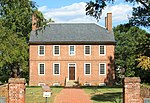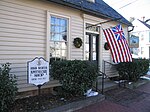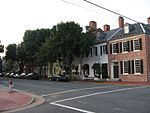Rowe House (Fredericksburg, Virginia)
Federal architecture in VirginiaGreek Revival houses in VirginiaHouses completed in 1859Houses in Fredericksburg, VirginiaHouses on the National Register of Historic Places in Virginia ... and 2 more
National Register of Historic Places in Fredericksburg, VirginiaNorthern Virginia Registered Historic Place stubs

The Rowe House is a historic home located at Fredericksburg, Virginia. It was built in 1828, and is a two-story, four-bay, double-pile, side-passage-plan Federal style brick dwelling. It has an English basement, molded brick cornice, deep gable roof, and two-story front porch. Attached to the house is a one-story, brick, two-room addition, also with a raised basement, and a one-story, late 19th century frame wing. The interior features Greek Revival-style pattern mouldings. Also on the property is a garden storage building built in about 1950, that was designed to resemble a 19th-century smokehouse.It was listed on the National Register of Historic Places in 2008.
Excerpt from the Wikipedia article Rowe House (Fredericksburg, Virginia) (License: CC BY-SA 3.0, Authors, Images).Rowe House (Fredericksburg, Virginia)
Day Street, Fredericksburg
Geographical coordinates (GPS) Address Nearby Places Show on map
Geographical coordinates (GPS)
| Latitude | Longitude |
|---|---|
| N 38.300277777778 ° | E -77.466111111111 ° |
Address
Maury Playground
Day Street
22402 Fredericksburg
Virginia, United States
Open on Google Maps










